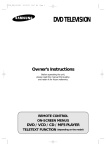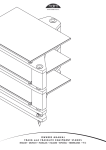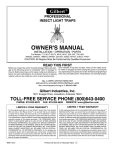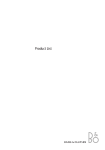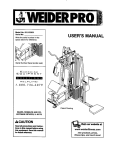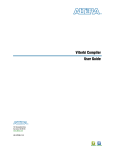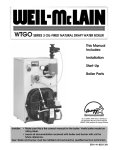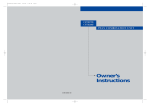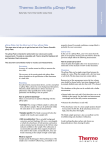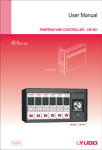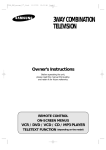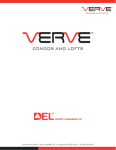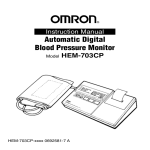Download Wireless Green Energy Meter USER MANUAL EMC
Transcript
BRANCH CIRCUIT POWER METER W EMR Energy Meter Router EMC Energy Meter Coordinator Wireless Green Energy Meter USER MANUAL ◆ Thank you for purchasing this product. 1. First of all, be sure to read this manual for correct use of the product. 2. If you find any missing contents or error, please inform us. 3. J&D electronics assumes no responsibility for any direct or indirect loss or damage which may occur through use of this product, regardless of any failure to perform on the part of this product. This document contains information that is the property of J&D electronics co., Ltd. and is furnished for the sole purpose of the operation and the maintenance of products. No part of this publication is to be used for any other purpose, and is not to be repurposed or translated into any human of computer language without the prior express written consent of this company. Copyright © 2012 by J&D electronics Co., Ltd. All rights reserved. 2 Table of Contents ◆ General Information 1. Certification related 6 2. Labeling 6 3. Glossary 6 4. safety instructions 7 5. General description 9 5.1 EMU(Energy Meter Unit) 10 5.2 EMC(Energy Meter Coordinator) 13 5.3 EMR(Energy Meter Router) 14 5.4 Handling multiple EMUs using Zigbee 14 ◆ Installing and Configuring Hardware 1. Before installation 16 2. Installing EMU 17 2.1 Detailed Description 17 2.2 Models Description 18 2.3 Installing the EMU body 20 2.4 LED display of EMU 21 2.5 Setting EMU ID and Baud rate 21 2.6 Mounting sensors 22 2.7 Connecting Voltage wires 23 3. Installing EMRs and EMC 25 4. Connencting EMC to PC 25 5. Installing the monitoring program 26 5.1 Setting of the address table. 27 5.2 Communication Monitoring 30 5.3 EMU 31 3 ◆ Software Interfaces 1. EMU related 4 34 1.1 Parameters and functions 34 1.2 Modbus commands 35 1.3 Modbus register map 35 1.4 Energy Register 52 1.5 Energy Counter Time Stamp Register 52 1.6 RMS Register 52 1.7 Power Register 52 1.8 Frequency 53 1.9 Angle 53 1.10 Status word 53 1.11 RSSI 53 1.12 Present Date / Time 53 1.13 Connection 54 1.14 CT type 54 1.15 PT type 54 1.16 Recording Interval time 54 1.17 Command Word 54 1.18 Recording Interval Time Stamp 55 1.19 Recording Interval-based Energy 55 1.20 Maximum Current in Interval 55 1.21 Minimum Voltage in Interval 55 1.22 Average Power Facor in Interval 55 1.23 Average Harmonic Reactive Power in Interval 55 1.24 Max Power (Demand Register) 55 1.25 Max Power Time stamp 55 2. EMR related 56 3. EMC related 56 3.1 Serial Port 56 3.2 Modbus Protocol 56 3.3 Modbus Register Tableused 57 3.4 Mac Address Fromat 57 4. Communication protocol 58 4.1 Frame structure of multiple registers for read 58 4.2 Frame structure of single register for write 58 ◆ Troubleshooting 59 ◆ Specifications 60 1. EMU specifications 60 2. EMR & EMC specifications 60 3. Measurement information 61 ◆ Manufacturer Information 62 1. Manufacturer 62 2. Documents and others 62 5 General Information 1. Certification related This product has been designed to comply with the following standards and directives : IEC 61010_1 : 2001 (Safety Specification) FCC Part 15, Class B FCC Part 15, Class C For more details, see this manual. 2. Labeling The label including the model name, identification number and etc. is placed on the back cover, The identification number of each device is placed on the bottom center of the back cover. 3. Glossary Wi-GEM ( Wireless Green Energy Meter) : Product name that consists of EMU, EMC, and EMR. EMU ( Energy Meter Unit) : Energy meter that collects the required electrical parameters. EMC ( Energy Meter Coordinator) : The network gateway. EMR (Energy Meter Router) : Router between EMU and EMC. RTC (Real Time Clock) Modbus : Communication protocol. L1/L2/L3/N : In case of 3-phase 4-wire, L1/L2/L3/N indicates the phases of power source. In case of 3-phase 3-wire, only L1/L2/L3 exist. In this manual, we use L1, L2, L3, and N. 6 4. Safety instructions DANGER If you do not follow the instructions in this manual, it may cause serious accidents. Only qualified persons from the manufacturer or agent must handle the inside components of the product. Owners, maintenance and service personnel, managers, operators, setters, programmers, foremen, mechanics, and all personnel related to these products must read and strictly follow the safety instructions in this manual. Please read the following warnings and cautions to prevent injury or damage to the product. DANGER This symbol alerts that ignoring an instruction or incorrect action may cause a death or serious injury. WARNING This symbol alerts that ignoring an instruction or incorrect action may cause minor injury or damage to the product. CAUTION This symbol alerts that ignoring an instruction or incorrect action may cause a Product malfunction or data or property loss. 7 CAUTION This symbol risk of electric shock. This symbol means protective conductor terminal. This symbol means alternating current. This symbol means both direct and alternating current. This symbol means direct current. 8 5. General description EMR Energy Meter Router EMC Energy Meter Router EMR Energy Meter Router Figure 1.1 Communication Concept Diagram To reduce power consumption or carbon emission, detailed power measurement for each process, line, and device is required. By installing Wi-GEM, detailed power measurement is enabled. Wi-GEM also can perform the following : Measurement of voltage, current, active/reactive power, apparent power, power factor, and frequency Measurememt of peak power Simultaneous event monitoring and storing for instantaneous low-voltage and over-current Because we open the Modbus protocol and register map for measurement, you can easily build your own system. 9 5.1 EMU ( Energy Meter Unit) EMU is the energy meter that collects the required electrical parameters at the specific interval after its sensors are fixed on the power cable. A single EMU can also be connected to a computer for analysis. An EMU can have 2 sensors that measure the electrical parameters for 3 phase 3 wire (L1/L2/L3). An EMU can have 3 sensors that measure the electrical parameters for 3phase 4wire (L1/L2/L3/N). It can support wirings for single phase, 3 phasese 3 wires, and pases 4 wires. Communication is possible by a single EMU or multiple EMUs. Figure 1.2 EMU Parts 10 NAME DIN Rail Fix Clip Fixing Screw Hole 1&2 Product Label Indentification Label DESCRIPTION To fix EMU onto a DIN rail, use this clip on back cover. To fix EMU on a wall of the distribution panel, insert screws in these holes and fasten them. The product label is placed here. The label si attached on the back cover. The ID can be set using the DIP switches or using a program. in case of using DIp switches, the maximum number of IDs is 63. With the program, maximum 255 IDs can be set while all DIP switches are off. LED Indicator It displays the current status. It can display various statuses. Power Inputs For 3 phase 4wire, Connect power input sources (L1, L2, L3, and N) For single phase, connect power input sources ( L1, N) For 3 phase 3wire, connect power input sources (L1, L2, L3) Zigbee If EMU needs to be directly connected to a PC, use the RS485 connection port. Connect P+ and N- of EMU with the USB port on a PC via the connector. It supports Zigbee or RS485 communication. Main features of EMU are as follows : Measuring instantaneous values for voltage, current, active power, reactive power, and apparent power of each phase Measuring accumulative values for active energy and reactive energy, apparent energy of each phase, and the total of each phase. Measurement of frequency : 50/60Hz Wide operating voltage : phase voltage 100 to 250 V~, L1-N Measurement of wide input voltages : Max. 250V Vrms, 3~, CAT III Measurement of input currents using the split core CT : 5A ~ 2500A Measurement of input currents using Rogowski coil : 250A ~ 5000A Power consumption : 2W Isolation : Isolation class II, IEC61010-1 CAT III Vrms 11 Measurement category : CAT III Environment : Indoor use Ambient operating temperature : -10 to +55℃ Ambient storage temperature: -25 to + 85℃ Mass : 160 g Maximum altitude : 2000 m Pollution degree : I Degree of protection : IP2x 2.4 GHz wireless ZigBee module Data logging into a PC Time stamps for each transmission data Logging interval: 1, 2, 3, 5, 6, 10, 15, 30, 60 minutes Easy installation and DIN rail mounting Modbus protocol Economic price A management program to be developed at user’s taste Voltage THD & Current THD Individual Harmonics 12 5.2 EMC (Energy Meter Coordinator) EMC (Energy Meter Coordinator) is the gateway that controls the wireless network and periodically gathers the collected data from EMUs. It can be accessed by an application program for data analysis. The program shows the power-related values such as voltage, current, frequency, etc. It is connected with PC via the USB cable. EMC has the following parts : NAME FUNCTION Fixing Screw Hole 1&2 To fix EMC on a wall, insert screws in these holes and fasten them. Antenna Used for wireless communication. DC Jack 5V DC (노란색 표기의 의미) RJ45 Connector Used to connect EMC with a PC. EMR does not have this port. Product Label The product label is placed. EMC Energy Meter Coordinator Figure 1.3 EMC 13 5.3 EMR (Energy Meter Router) EMR is the router that relays the data between EMU and EMC. It is automatically detected by an EMC. An EMC can connect EMRs up to 255 logically. r Ene gy Me ter Ro ute r EMR has the same shape as EMC except for USB connection port to a PC. EMR has no connection port. The adapter that is used to supply power must have been evaluated by UL. The DC power to EMR can use the DC adapter for 5 to 9 V. 5.4 Handling multiple EMUs using Zigbee If multiple EMUs need to be monitored and controlled, the collected data can be transferred to a wireless EMR via the wireless Energy Meter routers (EMR) as shown in Figure 1.1. Otherwise, an EMR is directly connected to an EMU. Each individual EMU has its own unique ID that can be set using the DIP switches inside EMU. Otherwise, users can use the factory default settings. The network communication has been implemented following the ZigBee specification. The communication features are: RF wireless frequency : 2.4 GHz IEEE 802.15. 4 compliant radio RF Data rate : 250 kbps Indoor Range : up to 60 m Outdoor RF line-of-sight Range : up to 1500m Transmit output power : 10mW Receiver Sensitivity : -102dBm Available network configurations are : 14 Single path network topology : EMC is connected to an EMR ( with an EMU) that is connected to another EMR ( with an EMU). Star-network topology : EMC is connected to multiple EMUs. Mesh network topology Figure 1.4 An Example of Mesh Network Topology 15 Installing and Configuring Hardware 1. Before installation DANGER Electrical shock or fire! This product can cause serious injury or death to persons if the instructions are not cautiously kept. CAUTION Follow the standard specifications and safety requirements. CAUTION Do not cut or forcibly pull the cabels. WARNING Only qualified persons must install the product. First of all, be sure to familiar with this manual. Perform the following suggestions for correct installation. If multiple EMUs are required to be installed, plan the layout of EMUs. For this purpose, think over the network topology and fixing method. Check whether any other interference generating devices exist or not. If so, relocate the installation location. Check whether the rated voltage and current on the label are correct. Install the product to the place that is not affected by strong magnetic field for correct operation and precision. The temperature must be within the operation temperature range. Do not install the product outdoors. The upper or lower clamp must be kept clean for correct operation and precision. Install the product following the instructions in this manual. An arbitrary installation may cause damage to the product or personal injury. Do not keep four side locks and power input terminal blocked for ventilation flow. 16 2. Installing EMU DANGER During EMU installation, be sure to turn off the power. CAUTION Do not apply physical damage to the product. If the clamp is separated or its insulation tube is stripped, it may cause infury or death. CAUTION Only qualified personnel must install EMU. WARNING Be sure to install EMU in the distribution panel with an additional lock. The EMU must be installed in a suitable rated UL Listed fire/electrical distribution panel(enclosure).Only the qualified personnel who follow standard safety precautions during all procedures must access the distribution panel. Those personnel should have appropriate traning and experience with high voltage devices. Appropriate safety gloves, safety glassed and protective clothing are recommended. CAUTION Be sure to follow the instruction in this manual during installation. Keep the specified specifications and regulations. 2.1 Detailed Description Data from the meter is sent to the gateway for uwer access periodically. The meter data is split into three sections : Energy Meter : Active, reacive and apparent evergy per phase and sum with a time-stamp. Recording interval meter : Active, reactive and apparent energy per phase and sum with a timestamp of the end of the recording interval; minimum voltage per phase and maximum current per phase during recording interval; frequency Meter Identification and Configuration : Meter configuration and version; recording inteval time setup, command and status word. Figure 1.5 : Energy Meter Node built with RT 17 2.2 Models Description Acceptable Good 1) Basic guidelines To obtain the best effectiveness of the network, apply the following recommendations. Do not install EMN in front of or close to metallic parts. That may reduce the efficiency of the embedded atenna. Avoil proximity of Electromagnetic Induction. Respect the illustrated layout to insure an optimized orientation of the antenna. 2) Inside a metallic cabinet When EMN has to be placed inside a metallic cabinet, its location is even more important. The cavinets are never completely sealed thanks to small open spaces and allow certain radio communication, but significantly reduce signal strength. To get the best effectiveness, apply the following recommendations : Figure 1.6 : Avoid the proximity of the antenna with metal parts Acceptable Acceptable Do not install EMN in the centre of the cabinet where most electrical cabels are located. Put EMN on one side, in front of any door slit or any window (If existing). If there is moe hole on bottom or top of the cabinet for cables pathways, put EMN in front of it. Add systematically a Mesh Node in the vicinity of the cabinet (1m) to ensure robust communications. 18 Figure 1.7 : EMU Location inside a metallic cabinet 3) Mesh Node location and connection Orientation of the nodes in relation to toher devices on the network impacts radio signal strength. Avoid placing Mesh Node right under an EMU. WARNING TAKE CARE IF FIXING MEST NODE HORIZONTALLY ON A METALLIC PLANE TO LET A MINI-MUM FREE INTERVAL (3-5MMS) BETWEEN BOTH AREAS IN REGARDS. YES YES NO NO YES Figure 1.3 : Location advising Best radio signal is observed when all Mesh Node devices are positioned horizontally : Good radio signal is also observed when one device is positioned horixontally and toher vertically : Radio signal is weaker, when all devices are positioned vertically : YES YES NO Figure 1.3 : Devices position 19 2.3 Installing the EMU body To keep effective wireless network communication, do not install EMU in front of interference generating materials or metal surfaces. If the embedded antenna is close to the material, it can decrease the efficiency of the embedded antenna. To mount the EMU on the wall, perform the following steps : 1. Prepare two screws. 2. Insert screws in the holes shown in Figure 1.2 and fasten them with a screwdriver. To mount the EMU onto a DIN rail, perform the following steps : 1. Insert the EMU onto the DIN rail and move it to a desired position. 2. Pull up the fix clip to fix the EMU. The Following figure shows an example of correct installation. Figure 2.1 Correct EMU Installation 20 2.4 LED display of EMU EMU has an LED lamp to display the current status as explained below : DESCRIPTION STATUS Run LED EMU operates in normal mode(fast flashing) Comm. LED EMU is performing the TX/RX communication WH LED Active Energy Pulse VarH LED Reacive Energy Pulse CAUTION If the green lamp does not blink after power supply, see 5. Troubleshooting and take a specified action. 2.5 Setting EMU ID and Baud rate DANGER Only the qualified personnel from the manufacturer or agent must set the EMU ID and baud rate. 21 2.6 Mounting sensors The sensor that measure electrical parameters are connected to an EMU. The sensors are fixed on power cables. so please keep the following cautions : DANGER The clamp must be attached to the wire with 300 V insulation capability. CAUTION Before installing a sensor, please check no current flows into the cable. CAUTION Clean the surface of the cable. Otherwise, foreign materials can cause a malfunction or incorrect measurement. CAUTION If phase allocation is wrong, incorrect energy data will be collected. CAUTION The allowable number of clamp openings is 50 times or below. Frequent clamp openings may shorten the life of clamp. To mount a sensor on the target cable, perform the following steps : 1. Place the sensor on the target cable according to the specified phase. 2. Keep the direction of the arrow sign on the sensor same as the current flow direction. 3. Close the sensor clamp over the cable. 4. To fix the sensor on the cable, use the cable tie. 22 2.7 Connecting voltage wires Now, connect the wires to the power input points (L1, L2, L3, N) at the bottom panel of EMU. CAUTION Before connection, be sure to check no current flows into the wires. CAUTION The wire must have been covered by the tube with 300 V insulation capability. The size of the conductor must be within the range of1.0 to 6.0 mm (17 AWG to 10 AWG). CAUTION For supply connection, use wiring materials suitable for at least 75℃. CAUTION Make sure that connection of power supply should have provision for connection of one of the wiring system in accordance with the National Electrical Code, ANSI/NFPA 70, NEC, with CSA C22.1, CEC, Part I or with both as appropriate. CAUTION For protection, the circuit breaker must be installed between the voltage wire and power. The maximum rating of circuit breaker is 20A, then minimum size of branch circuit wiring will be used with 12 AWG. The following explains how to connect the wires for each case. Wiring for 4 phases 3 wires 23 Wiring for 3 phases 3 wires Wiring for Single phases 2wires 24 3. Installing EMRs and EMC According to the prepared topology plan, install EMRs near the installed EMUs. Then install EMC near the monitoring computer. Power connection to EMR USB connection to EMC Figure 2.2 Installation of EMR and EMC 4. Connecting EMC to PC EMC is configured for the MODBUS protocol. when the EMC is turned on, the network starts building the structure. It may take a while. For connection between EMC and PC, EMC has a RS232 port on it by RJ45. If there is no RS232 port on PC, Use a USB Serial Converter for Comm. 25 The pin numvers for RS232 port cabling are below RS232 Port(RJ45) Signal Name Pin Number TX 4 RX 5 GND 3, 6 The serial port settings of modbus master are below for Modbus RTU protocol communication. Signal Name Pin Number TX 4 RX 5 GND 3, 6 5. Installing the MMI software and Settings The diagram below shows the protocol transformation concept between Zigbee and Modbus protocol. 26 5.1 Setting of the address table. 1) Editing Mac address. EMC is a device acts as a MODbus gateway. it relays the protocol between Modbus protocol and Zigbee protocol. All EMUs are allocated with its own MAC addresses. It is written on the label of EMU. To read the data of EMU with Modbus protocol, it needs to transform the Modbus address into MAC address. EMC performs it’s process using the internal address transformation table. The transformation table includes MAC address area, Modbus address area and the name area to be able to distinguish the EMU each. Input the MAC address first and then input the Modbus address and the name responding to it one by one. For example, if the MAC address is “91BCF9”, the Modbus address is “1”, and the name is “EMU#1”, the table forms as 91, BC, F9, 1, EMU#1. 91 BC F9 1 EMU#1 91 BC F4 2 EMU#2 6C 3 EMU#3 91 BC After input the addresses and store it with “.csv” ilename extension. 27 2) Import After making a “mac.csv” file in the folder which the MMI software is installed, run the MMI software “Wigem manager’ by clicking the program icon WiGEM. When it is loaded, it reads the ”mac. csv” file and displays the contents on the window automatically. The “coordinator window” displays MAC address, Modbus address, EMU name on the “MAC Address” table. In case of reading a “mac.csv” file again during the MMI software running. Run the [File-Reload Mac File] menu. 28 3) Download To transfer the MAC address impoted to the EMC, click the [Comm.-connect] menu. Then the “Open Serial Port” window pops up. Select a com. port and click O.K button and the communication port is opened. After select the “MAC address” tap at the “Coordinator window” and push the “Download to EMC” menu button. When the download is completed, the “Download Success” message displays on the “Message” 4) Upload It uses the MAC address stored in the EMC. When click the “Upload From EMC” menu button, It displays the MAC address read on the table. EMC does noto store the device name and reserves it as blank. 29 5.2 Communication Monitoring 1) When click the [Comm.-Enable Scan] menu at the Main menu, it requests the data in the table on by one in order When click the [Comm.-Disable Scan] menu at the Main menu, it stops all communication with EMU. 2) When click “Network” menu tab at the “Coordinator window”, it shows sending and receiving count, fail count on the table. Tx Count : Whenever it sends the request fraim, it counts up one by one. Rx Count : Whenever it receives the response fraim, it counts up one by one. Tx Fail : It is sum of subract Rx Count from Tx Coun. Whenever the communication fails, it increases the number one by one. Enabled : It displays the status of EMU each. If it is at no scan status, it displays it by “Disabled” and displays it by “ Enabled” at scan staus. When it stops and activates the Comm. for a designated specific EMU, double click the row of EMU in the table and pops up the “Dialog window” as like below. If it needs to stop the Coom., check off it in the small check bos. and click O.K button, and then the background color of the EMU changes into “yellow” and stops scanning. 30 RSSI : Displays the receiving radio signal intensity of EMU. Interval : Displays the Recording Interval of EMU. 5.3 EMU 1. LED RUN Comm. The LED is flickering in normal status When it joins Zigbee network, the LED turns on. When it activates Comm. the LED is flickering. WH Active Energy Pulse VarH Reacive Energy Pulse 2. Measurement 1) Select the “Metering Window” and EMU to be monitored in the Combo box. 31 2) Select the “Metering Window” and Harmonics to be monitored in the Combo box. 31 2) The Measurement information of EMU is displayed in the “Energy” tab and “Realtime” tab devided. 3) Energy Data MMU software “Wi-GEM Manager” shows the data below. Energy Register - Active Energy : Displays Active Energy of each phase and total. The unit is Watt/h - Reactive Energy : Displays Reacive Energy of each pahse and total. The unit is Var/h - Apparent Energy : Displays Apparent Energy of each phase and total. The unit is VA/h. Time Stamp : Displays the updated time of the Energy Register newly. Unit range is 0 ~ 999,999,999. Recording Interval 32 It measures the Energy in a certain period of time. The ime units to be set are 1, 1, 2, 3, 4, 5, 6, 10, 12, 15, 20, 30, 60 minutes. It criteria of time is based on the internal timer of EMU. When it time is up, EMU stores the gathered data in the “Recording Interval Register” and initializes it. - Active Energy : Displays Active Energy of each phase and total. The unit is Watt/h. - Reactive Energy : Displays Reactive Energy of each phase and total. The unit is Var/h. - Apparent Energy : Displays Apparent Energy of each phase and total. The unit is VA/h. - Time Stamp : Displays the updated time of the Recording Interval Register newly. Demand Register - Max. Active Power, Time Stamp - Max. Reacive Power, Time Stamp - Max. Apparent Power, Time Stamp It records the maximum power value after comparing the present on and the prior one, whenever the “Recording Interval data” is generated. And it records the time simultaneously. 4) Real Time Data RMS Value : Voltage, Current Power : Active, Reactive, Apparent Frequency Phase Angle Status : The value becomes “1”, when the frequency o voltage engaged to EMU is in the range of 45~65Hz. RSSI : The receiving radio signal intensity. Recording Interval : It defines the time for the each section. It set the value by divisor of 60minute. For example, it becomes 1, 2, 3, 4, 5, 6, 10, 12, 15, 20, 30, 60. CT Ratio : Input the primary CT rating raitio. For example, if the CT rating current is 100A, Input the value of 100. CT should be used with the designated one made by manufacturer. PT Ratio : If the EMU is connected to a PT for a high voltage application, Input the PT ratio. In case of direct connection, it displays by “1” Zero Power Level : The threshold value to define the unload status of power. 33 Software Interfaces To program a customer specific application, the following software developmetn data is required. 1. EMU related 1.1 Parameters and functions The related parameters and functins are : MODEL Wi-GEM Power system 1P2W, 2P3W, 3P3W, 3P4W 90 ~ 264 VAC ( Line to Neutral ) 90 ~ 264 VAC ( Line to Line for 3P3W) 156 ~ 457 VAC ( Line to Line for 3P4W) Voltage Current Inputs Rating Primary with Split core CT : 50 ~ 2,400A with Rogoskii coil CT : 250 ~ 5,000A Secondary 100mA/100mV (CT secondary side) Frequency 45 ~ 65 Hz Accuracy 1.0 Class Power Consumption Less than 2W Communication ZigBee ( 250 kbps ) Operation Temp. -10 C ~ 55 C Storage Temp. -25 C ~ 70 C Standards IEC 62052-21 Measurement Item Real time 34 Unit Digit Remark Phase voltage V Floating point 1P2W, 2P3W, 3P4W Line voltage V Floating point 3P3W Line current A Floating point Active power W Floating point Phase Reactive power Var Floating point Phase Apparent power VA Floating point Phase Interval Recording Demand Power Frequency Hz 45.00 ~ 65.00 RSSI dB 0 ~ 255 Signal intensity Pahse angle degree 0.00 ~ 360.00 Between Voltage and Current Active Energy WH 0.0 ~ 999,999,999 Phase, Total Reactive Energy VarH 0.0 ~ 999,999,999 Phase, Total Apparent Energy VAH 0.0 ~ 999,999,999 Phase, Total Active Energy WH 0.0 ~ 999,999,999 Phase, Total Reactive Energy VarH 0.0 ~ 999,999,999 Phase, Total Apparent Energy VAH 0.0 ~ 999,999,999 Phase, Total Max Current A Floating point Phase Min Voltage V Floating point Phase Average PF % 0.00 ~ 100.00 THD % 0.00 ~ 100.00 Harmonics reactive power Max Active power W Unsigned int 32bit Total Max Reactive power Var Unsigned int 32bit Total Max Apparent power VA Unsigned int 32bit Total Sec, Min, Hour, day, Month, Year Time stamp Recording Interval time % 0.00 ~ 100.00 1.2 Modbus commands The commands used in the Modbus register map are : Read holding register (0x03) Write single register (0x06) Write multiple register (0x16) 1.3 Modbus register map * MSW : Most Significant Word, LSW : LeastSignificant Word * NV : Non-volatile, V : Volatile, S : Signed, U : Unsigned, R : Read, W : 35 Word Address Name FC Unit Word Size Data Type Meter Data 36 0 Current, Phase 1 4 2 FLOAT 2 Current, Phase 2 4 2 FLOAT 4 Current, Phase 3 4 2 FLOAT 6 Current, Phase Total 4 2 FLOAT 8 Reserved 4 2 FLOAT 10 Reserved 4 2 FLOAT 12 Voltage, Phase 1 4 2 FLOAT 14 Voltage, Phase 2 4 2 FLOAT 16 Voltage, Phase 3 4 2 FLOAT 18 Voltage, Phase Total Average 4 2 FLOAT 20 Watt, Phase 1 4 2 FLOAT 22 Watt, Phase 2 4 2 FLOAT 24 Watt, Phase 3 4 2 FLOAT 26 Watt, Phase Total 4 2 FLOAT 28 Var, Phase 1 4 2 FLOAT 30 Var, Phase 2 4 2 FLOAT 32 Var, Phase 3 4 2 FLOAT 34 Var, Phase Total 4 2 FLOAT 36 VA, Phase 1 4 2 FLOAT 38 VA, Phase 2 4 2 FLOAT 40 VA, Phase 3 4 2 FLOAT 42 VA, Phase Total 4 2 FLOAT 44 Angle, V1-l1 4 2 FLOAT 46 Angle, V1-l2 4 2 FLOAT 48 Angle, V1-l3 4 2 FLOAT 50 Power factor, Phase 1 4 2 FLOAT 52 Power factor, Phase 2 4 2 FLOAT 54 Power factor, Phase 3 4 2 FLOAT 56 Power factor, Phase Average 4 2 FLOAT 58 Lline frequency 4 2 FLOAT 60 Status Word 4 2 FLOAT A V WATT VAR VAR Degree % Hz Comment Word Address Name FC Unit Word Size Data Type 61 Status Word 4 1 U16 62 Current, Phase 1 4 2 U16 63 Current, Phase 2 4 2 U16 64 Current, Phase 3 4 2 U16 65 Current, Phase Total 4 2 U16 66 Reserved 4 2 U16 67 Reserved 4 2 U16 68 Voltage, Phase 1 4 2 U16 69 Voltage, Phase 2 4 2 U16 70 Voltage, Phase 3 4 2 U16 71 Voltage, Phase Total Average 4 2 U16 72 Watt, Phase 1 4 2 U16 73 Watt, Phase 2 4 2 U16 74 Watt, Phase 3 4 2 U16 75 Watt, Phase Total 4 2 U16 76 Watt/Hr, Phase 1 4 2 U32 78 Watt/Hr, Phase 2 4 2 U32 2 U32 80 4 W/HR 82 Watt/Hr, Total 4 2 U32 84 Fundamental Watt/Hr, Phase 1 4 2 U32 86 Fundamental Watt/Hr, Phase 2 4 2 U32 88 Fundamental Watt/Hr, Phase 3 4 2 U32 90 Fundamental Watt/Hr, Total 4 2 U32 92 Fundamental Watt/Hr, Phase 1 4 2 U32 94 Fundamental Watt/Hr, Phase 2 4 2 U32 96 Fundamental Watt/Hr, Phase 3 4 2 U32 4 2 U32 2 U32 2 U32 2 U32 2 U32 98 100 VA/Hr, Phase 1 4 102 VA/Hr, Phase 2 4 104 VA/Hr, Phase 3 4 106 VA/Hr, Phase Total 4 W/HR VAR/H VA/H Comment 0 ~ 99,999,999 0 ~ 999,999,999 0 ~ 99,999,999 0 ~ 999,999,999 0 ~ 99,999,999 0 ~ 999,999,999 0 ~ 99,999,999 0 ~ 999,999,999 37 Word Address Name FC Unit Word Size Data Type 108 VTHD, Phase 1 4 1 U16 109 VTHD, Phase 2 4 1 U16 110 VTHD, Phase 3 4 1 U16 111 VTHD, Phase Average 4 1 U16 112 ITHD, Phase 1 4 1 U16 113 ITHD, Phase 2 4 1 U16 114 ITHD, Phase 3 4 1 U16 115 ITHD, Average 4 1 U16 116 Reserved 4 1 U16 117 Reserved 4 1 U16 118 Reserved 4 1 U16 119 Reserved 4 1 U16 Comment 0 ~ 39900 (0.00 ~ 399.00 %) 0 ~ 39900 (0.00 ~ 399.00 %) Configuration 38 120 Time Stamp 4.16 3 TS 123 Reserved 4.6 1 U16 124 Reserved 4.6 1 U16 125 Connection Type 4.6 1 U16 126 # of CT Turn 4.6 1 U16 1 ~ 10(default:1) 127 CT Ratio 4.6 1 U16 1 ~ 65535(default:100) 128 PT Ratio 4.6 1 U16 1 ~ 65535(default:220) 129 Demand Period 4.6 1 U16 1/5/10/15/30/60(default:15) 130 ZERO Power 4.6 1 U16 1 ~ 20(0.0001%~0.002%, default:10) 131 Reserved 4.6 1 U16 132 Reserved 4.6 2 U32 134 Reserved 4.6 1 U16 135 Reserved 4.6 1 U16 136 Reserved 4.6 1 U16 137 Reserved 4.6 1 U16 138 Reserved 4.6 1 U16 139 Reserved 4.6 1 U16 140 Reserved 4.6 1 U16 141 Reserved 4.6 1 U16 0:3P4W, 1:3P3W, 2:1P3W, 3:1P2W Word Address Name FC Unit Word Size Data Type 142 Reserved 4,6 1 U16 143 Reserved 4,6 1 U16 144 Reserved 4,6 1 U16 145 Reserved 4,6 1 U16 146 Reserved 4,6 1 U16 147 Reserved 4,6 1 U16 148 Reserved 4,6 1 U16 149 Reserved 4,6 1 U16 Comment Demand 150 Time Stamp 4 3 TS 153 Reserved 4 1 U16 154 Volt Demand, Phase 1 4 2 FLOAT 156 Volt Demand, Phase 2 4 2 FLOAT 158 Volt Demand, Phase 3 4 2 FLOAT 160 Current Demand, Phase 1 4 2 FLOAT 162 Current Demand, Phase 2 4 2 FLOAT 164 Current Demand, Phase 3 4 2 FLOAT 166 Watt Demand 4 2 FLOAT 168 Var Demand 4 2 FLOAT 170 VA Demand 4 2 FLOAT 172 Reserved 4 2 FLOAT 174 Cumulative Watt Demand 4 2 FLOAT 176 Cumulative Var Demand 4 2 FLOAT 178 Cumulative VA Demand 4 2 FLOAT 180 Min. Volt, Phase 1 4 2 FLOAT 182 Min. Volt, Phase 2 4 2 FLOAT 184 Min. Volt, Phase 3 4 2 FLOAT 186 Max. Current, Phase 1 4 2 FLOAT 188 Max. Current, Phase 2 4 2 FLOAT 190 Max. Current, Phase 3 4 2 FLOAT 192 Max. Demand Watt 4 2 FLOAT 194 Max. Demand Var 4 2 FLOAT 39 Word Address Name FC Unit Word Size Data Type 196 Max Demand VA 4 2 FLOAT 198 Reserved 4 1 U16 200 Reserved 4 1 U16 202 Reserved 4 1 U16 204 Reserved 4 1 U16 206 Reserved 4 1 U16 207 Reserved 4 1 U16 208 Reserved 4 1 U16 209 Reserved 4 1 U16 Comment Harmonic 40 210 2nd VHD, Phase 1 4 % 1 U16 211 2nd VHD, Phase 2 4 % 1 U16 212 2nd VHD, Phase 3 4 % 1 U16 213 2nd IHD, Phase 1 4 % 1 U16 214 2nd IHD, Phase 2 4 % 1 U16 215 2nd IHD, Phase 3 4 % 1 U16 216 3rd VHD, Phase 1 4 % 1 U16 217 3rd VHD, Phase 2 4 % 1 U16 218 3rd VHD, Phase 3 4 % 1 U16 219 3rd IHD, Phase 1 4 % 1 U16 220 3rd IHD, Phase 2 4 % 1 U16 221 3rd IHD, Phase 3 4 % 1 U16 222 4th VHD, Phase 1 4 % 1 U16 223 4th VHD, Phase 2 4 % 1 U16 224 4th VHD, Phase 3 4 % 1 U16 225 4th IHD, Phase 1 4 % 1 U16 226 4th IHD, Phase 2 4 % 1 U16 227 4th IHD, Phase 3 4 % 1 U16 228 5th VHD, Phase 1 4 % 1 U16 229 5th VHD, Phase 2 4 % 1 U16 230 5th VHD, Phase 3 4 % 1 U16 0 ~ 39900(0.00 ~ 399.00%) Word Address Name FC Unit Word Size Data Type 231 5th IHD, Phase 1 4 % 1 U16 232 5th IHD, Phase 2 4 % 1 U16 233 5th IHD, Phase 3 4 % 1 U16 234 6th VHD, Phase 1 4 % 1 U16 235 6th VHD, Phase 2 4 % 1 U16 236 6th VHD, Phase 3 4 % 1 U16 237 6th IHD, Phase 1 4 % 1 U16 238 6th IHD, Phase 2 4 % 1 U16 239 6th IHD, Phase 3 4 % 1 U16 240 7th VHD, Phase 1 4 % 1 U16 241 7th VHD, Phase 2 4 % 1 U16 242 7th VHD, Phase 3 4 % 1 U16 243 7th IHD, Phase 1 4 % 1 U16 244 7th IHD, Phase 2 4 % 1 U16 245 7th IHD, Phase 3 4 % 1 U16 246 8th VHD, Phase 1 4 % 1 U16 247 8th VHD, Phase 2 4 % 1 U16 248 8th VHD, Phase 3 4 % 1 U16 249 8th IHD, Phase 1 4 % 1 U16 250 8th IHD, Phase 2 4 % 1 U16 251 8th IHD, Phase 3 4 % 1 U16 252 9th VHD, Phase 1 4 % 1 U16 253 9th VHD, Phase 2 4 % 1 U16 254 9th VHD, Phase 3 4 % 1 U16 255 9th IHD, Phase 1 4 % 1 U16 256 9th IHD, Phase 2 4 % 1 U16 257 9th IHD, Phase 3 4 % 1 U16 258 10th VHD, Phase 1 4 % 1 U16 259 10th VHD, Phase 2 4 % 1 U16 260 10th VHD, Phase 3 4 % 1 U16 261 10th IHD, Phase 1 4 % 1 U16 262 10th IHD, Phase 2 4 % 1 U16 Comment 0 ~ 39900(0.00 ~ 399.00%) 41 Word Address 42 Name FC Unit Word Size Data Type 263 10th IHD, Phase 3 4 % 1 U16 264 11th VHD, Phase 1 4 % 1 U16 265 11th VHD, Phase 2 4 % 1 U16 266 11th VHD, Phase 3 4 % 1 U16 267 11th IHD, Phase 1 4 % 1 U16 268 11th IHD, Phase 2 4 % 1 U16 269 11th IHD, Phase 3 4 % 1 U16 270 12th VHD, Phase 1 4 % 1 U16 271 12th VHD, Phase 2 4 % 1 U16 272 12th VHD, Phase 3 4 % 1 U16 273 12th IHD, Phase 1 4 % 1 U16 274 12th IHD, Phase 2 4 % 1 U16 275 12th IHD, Phase 3 4 % 1 U16 276 13th VHD, Phase 1 4 % 1 U16 277 13th VHD, Phase 2 4 % 1 U16 278 13th VHD, Phase 3 4 % 1 U16 279 13th IHD, Phase 1 4 % 1 U16 280 13th IHD, Phase 2 4 % 1 U16 281 13th IHD, Phase 3 4 % 1 U16 282 14th VHD, Phase 1 4 % 1 U16 283 14th VHD, Phase 2 4 % 1 U16 284 14th VHD, Phase 3 4 % 1 U16 285 14th IHD, Phase 1 4 % 1 U16 286 14th IHD, Phase 2 4 % 1 U16 287 14th IHD, Phase 3 4 % 1 U16 288 15th VHD, Phase 1 4 % 1 U16 289 15th VHD, Phase 2 4 % 1 U16 290 15th VHD, Phase 3 4 % 1 U16 291 15th IHD, Phase 1 4 % 1 U16 292 15th IHD, Phase 2 4 % 1 U16 293 15th IHD, Phase 3 4 % 1 U16 294 16th VHD, Phase 1 4 % 1 U16 Comment 0 ~ 39900(0.00 ~ 399.00%) Word Address Name FC Unit Word Size Data Type 295 16th VHD, Phase 2 4 % 1 U16 296 16th VHD, Phase 3 4 % 1 U16 297 16th IHD, Phase 1 4 % 1 U16 298 16th IHD, Phase 2 4 % 1 U16 299 16th IHD, Phase 3 4 % 1 U16 300 17th VHD, Phase 1 4 % 1 U16 301 17th VHD, Phase 2 4 % 1 U16 302 17th VHD, Phase 3 4 % 1 U16 303 17th IHD, Phase 1 4 % 1 U16 304 17th IHD, Phase 2 4 % 1 U16 305 17th IHD, Phase 3 4 % 1 U16 306 18th VHD, Phase 1 4 % 1 U16 307 18th VHD, Phase 2 4 % 1 U16 308 18th VHD, Phase 3 4 % 1 U16 309 18th IHD, Phase 1 4 % 1 U16 310 18th IHD, Phase 2 4 % 1 U16 311 18th IHD, Phase 3 4 % 1 U16 312 19th VHD, Phase 1 4 % 1 U16 313 19th VHD, Phase 2 4 % 1 U16 314 19th VHD, Phase 3 4 % 1 U16 315 19th IHD, Phase 1 4 % 1 U16 316 19th IHD, Phase 2 4 % 1 U16 317 19th IHD, Phase 3 4 % 1 U16 318 20th VHD, Phase 1 4 % 1 U16 319 20th VHD, Phase 2 4 % 1 U16 320 20th VHD, Phase 3 4 % 1 U16 321 20th IHD, Phase 1 4 % 1 U16 322 20th IHD, Phase 2 4 % 1 U16 323 20th IHD, Phase 3 4 % 1 U16 324 21st VHD, Phase 1 4 % 1 U16 325 21st VHD, Phase 2 4 % 1 U16 326 21st VHD, Phase 3 4 % 1 U16 Comment 0 ~ 39900(0.00 ~ 399.00%) 43 Word Address 44 Name FC Unit Word Size Data Type 327 21st IHD, Phase 1 4 % 1 U16 328 21st IHD, Phase 2 4 % 1 U16 329 21st IHD, Phase 3 4 % 1 U16 330 22nd VHD, Phase 1 4 % 1 U16 331 22nd VHD, Phase 2 4 % 1 U16 332 22nd VHD, Phase 3 4 % 1 U16 333 22nd IHD, Phase 1 4 % 1 U16 334 22nd IHD, Phase 2 4 % 1 U16 335 22nd IHD, Phase 3 4 % 1 U16 336 23rd VHD, Phase 1 4 % 1 U16 337 23rd VHD, Phase 2 4 % 1 U16 338 23rd VHD, Phase 3 4 % 1 U16 339 23rd IHD, Phase 1 4 % 1 U16 340 23rd IHD, Phase 2 4 % 1 U16 341 23rd IHD, Phase 3 4 % 1 U16 342 24th VHD, Phase 1 4 % 1 U16 343 24th VHD, Phase 2 4 % 1 U16 344 24th VHD, Phase 3 4 % 1 U16 345 24th IHD, Phase 1 4 % 1 U16 346 24th IHD, Phase 2 4 % 1 U16 347 24th IHD, Phase 3 4 % 1 U16 348 25th VHD, Phase 1 4 % 1 U16 349 25th VHD, Phase 2 4 % 1 U16 350 25th VHD, Phase 3 4 % 1 U16 351 25th IHD, Phase 1 4 % 1 U16 352 25th IHD, Phase 2 4 % 1 U16 353 25th IHD, Phase 3 4 % 1 U16 354 26th VHD, Phase 1 4 % 1 U16 355 26th VHD, Phase 2 4 % 1 U16 356 26th VHD, Phase 3 4 % 1 U16 357 26th IHD, Phase 1 4 % 1 U16 358 26th IHD, Phase 2 4 % 1 U16 Comment 0 ~ 39900(0.00 ~ 399.00%) Word Address Name FC Unit Word Size Data Type 359 26th IHD, Phase 3 4 % 1 U16 360 27th VHD, Phase 1 4 % 1 U16 361 27th VHD, Phase 2 4 % 1 U16 362 27th VHD, Phase 3 4 % 1 U16 363 27th IHD, Phase 1 4 % 1 U16 364 27th IHD, Phase 2 4 % 1 U16 365 27th IHD, Phase 3 4 % 1 U16 366 28th VHD, Phase 1 4 % 1 U16 367 28th VHD, Phase 2 4 % 1 U16 368 28th VHD, Phase 3 4 % 1 U16 369 28th IHD, Phase 1 4 % 1 U16 370 28th IHD, Phase 2 4 % 1 U16 371 28th IHD, Phase 3 4 % 1 U16 372 29th VHD, Phase 1 4 % 1 U16 373 29th VHD, Phase 2 4 % 1 U16 374 29th VHD, Phase 3 4 % 1 U16 375 29th IHD, Phase 1 4 % 1 U16 376 29th IHD, Phase 2 4 % 1 U16 377 29th IHD, Phase 3 4 % 1 U16 378 30th VHD, Phase 1 4 % 1 U16 379 30th VHD, Phase 2 4 % 1 U16 380 30th VHD, Phase 3 4 % 1 U16 381 30th IHD, Phase 1 4 % 1 U16 382 30th IHD, Phase 2 4 % 1 U16 383 30th IHD, Phase 3 4 % 1 U16 384 31st VHD, Phase 1 4 % 1 U16 385 31st VHD, Phase 2 4 % 1 U16 386 31st VHD, Phase 3 4 % 1 U16 387 31st IHD, Phase 1 4 % 1 U16 388 31st IHD, Phase 2 4 % 1 U16 389 31st IHD, Phase 3 4 % 1 U16 390 32nd VHD, Phase 1 4 % 1 U16 Comment 0 ~ 39900(0.00 ~ 399.00%) 45 Word Address 46 Name FC Unit Word Size Data Type 391 32nd VHD, Phase 2 4 % 1 U16 392 32nd VHD, Phase 3 4 % 1 U16 393 32nd IHD, Phase 1 4 % 1 U16 394 32nd IHD, Phase 2 4 % 1 U16 395 32nd IHD, Phase 3 4 % 1 U16 396 33rd VHD, Phase 1 4 % 1 U16 397 33rd VHD, Phase 2 4 % 1 U16 398 33rd VHD, Phase 3 4 % 1 U16 399 33rd IHD, Phase 1 4 % 1 U16 400 33rd IHD, Phase 2 4 % 1 U16 401 33rd IHD, Phase 3 4 % 1 U16 402 34th VHD, Phase 1 4 % 1 U16 403 34th VHD, Phase 2 4 % 1 U16 404 34th VHD, Phase 3 4 % 1 U16 405 34th IHD, Phase 1 4 % 1 U16 406 34th IHD, Phase 2 4 % 1 U16 407 34th IHD, Phase 3 4 % 1 U16 408 35th VHD, Phase 1 4 % 1 U16 409 35th VHD, Phase 2 4 % 1 U16 410 35th VHD, Phase 3 4 % 1 U16 411 35th IHD, Phase 1 4 % 1 U16 412 35th IHD, Phase 2 4 % 1 U16 413 35th IHD, Phase 3 4 % 1 U16 414 36th VHD, Phase 1 4 % 1 U16 415 36th VHD, Phase 2 4 % 1 U16 416 36th VHD, Phase 3 4 % 1 U16 417 36th IHD, Phase 1 4 % 1 U16 418 36th IHD, Phase 2 4 % 1 U16 419 36th IHD, Phase 3 4 % 1 U16 420 37th VHD, Phase 1 4 % 1 U16 421 37th VHD, Phase 2 4 % 1 U16 422 37th VHD, Phase 3 4 % 1 U16 Comment 0 ~ 39900(0.00 ~ 399.00%) Word Address Name FC Unit Word Size Data Type 423 37th IHD, Phase 1 4 % 1 U16 424 37th IHD, Phase 2 4 % 1 U16 425 37th IHD, Phase 3 4 % 1 U16 426 38th VHD, Phase 1 4 % 1 U16 427 38th VHD, Phase 2 4 % 1 U16 428 38th VHD, Phase 3 4 % 1 U16 429 38th IHD, Phase 1 4 % 1 U16 430 38th IHD, Phase 2 4 % 1 U16 431 38th IHD, Phase 3 4 % 1 U16 432 39th VHD, Phase 1 4 % 1 U16 433 39th VHD, Phase 2 4 % 1 U16 434 39th VHD, Phase 3 4 % 1 U16 435 39th IHD, Phase 1 4 % 1 U16 436 39th IHD, Phase 2 4 % 1 U16 437 39th IHD, Phase 3 4 % 1 U16 438 40th VHD, Phase 1 4 % 1 U16 439 40th VHD, Phase 2 4 % 1 U16 440 40th VHD, Phase 3 4 % 1 U16 441 40th IHD, Phase 1 4 % 1 U16 442 40th IHD, Phase 2 4 % 1 U16 443 40th IHD, Phase 3 4 % 1 U16 444 41st VHD, Phase 1 4 % 1 U16 445 41st VHD, Phase 2 4 % 1 U16 446 41st VHD, Phase 3 4 % 1 U16 447 41st IHD, Phase 1 4 % 1 U16 448 41st IHD, Phase 2 4 % 1 U16 449 41st IHD, Phase 3 4 % 1 U16 450 42nd VHD, Phase 1 4 % 1 U16 451 42nd VHD, Phase 2 4 % 1 U16 452 42nd VHD, Phase 3 4 % 1 U16 453 42nd IHD, Phase 1 4 % 1 U16 454 42nd IHD, Phase 2 4 % 1 U16 Comment 0 ~ 39900(0.00 ~ 399.00%) 47 Word Address 48 Name FC Unit Word Size Data Type 455 42nd IHD, Phase 3 4 % 1 U16 456 43rd VHD, Phase 1 4 % 1 U16 457 43rd VHD, Phase 2 4 % 1 U16 458 43rd VHD, Phase 3 4 % 1 U16 459 43rd IHD, Phase 1 4 % 1 U16 460 43rd IHD, Phase 2 4 % 1 U16 461 43rd IHD, Phase 3 4 % 1 U16 462 44th VHD, Phase 1 4 % 1 U16 463 44th VHD, Phase 2 4 % 1 U16 464 44th VHD, Phase 3 4 % 1 U16 465 44th IHD, Phase 1 4 % 1 U16 466 44th IHD, Phase 2 4 % 1 U16 467 44th IHD, Phase 3 4 % 1 U16 468 45th VHD, Phase 1 4 % 1 U16 469 45th VHD, Phase 2 4 % 1 U16 470 45th VHD, Phase 3 4 % 1 U16 471 45th IHD, Phase 1 4 % 1 U16 472 45th IHD, Phase 2 4 % 1 U16 473 45th IHD, Phase 3 4 % 1 U16 474 46th VHD, Phase 1 4 % 1 U16 475 46th VHD, Phase 2 4 % 1 U16 476 46th VHD, Phase 3 4 % 1 U16 477 46th IHD, Phase 1 4 % 1 U16 478 46th IHD, Phase 2 4 % 1 U16 479 46th IHD, Phase 3 4 % 1 U16 480 47th VHD, Phase 1 4 % 1 U16 481 47th VHD, Phase 2 4 % 1 U16 482 47th VHD, Phase 3 4 % 1 U16 483 47th IHD, Phase 1 4 % 1 U16 484 47th IHD, Phase 2 4 % 1 U16 485 47th IHD, Phase 3 4 % 1 U16 486 48th VHD, Phase 1 4 % 1 U16 Comment 0 ~ 39900(0.00 ~ 399.00%) Word Address Name FC Unit Word Size Data Type 487 48th VHD, Phase 2 4 % 1 U16 488 48th VHD, Phase 3 4 % 1 U16 489 48th IHD, Phase 1 4 % 1 U16 490 48th IHD, Phase 2 4 % 1 U16 491 48th IHD, Phase 3 4 % 1 U16 492 49th VHD, Phase 1 4 % 1 U16 493 49th VHD, Phase 2 4 % 1 U16 494 49th VHD, Phase 3 4 % 1 U16 495 49th IHD, Phase 1 4 % 1 U16 496 49th IHD, Phase 2 4 % 1 U16 497 49th IHD, Phase 3 4 % 1 U16 498 50th VHD, Phase 1 4 % 1 U16 499 50th VHD, Phase 2 4 % 1 U16 500 50th VHD, Phase 3 4 % 1 U16 501 50th IHD, Phase 1 4 % 1 U16 502 50th IHD, Phase 2 4 % 1 U16 503 50th IHD, Phase 3 4 % 1 U16 504 51st VHD, Phase 1 4 % 1 U16 505 51st VHD, Phase 2 4 % 1 U16 506 51st VHD, Phase 3 4 % 1 U16 507 51st IHD, Phase 1 4 % 1 U16 508 51st IHD, Phase 2 4 % 1 U16 509 51st IHD, Phase 3 4 % 1 U16 510 52nd VHD, Phase 1 4 % 1 U16 511 52nd VHD, Phase 2 4 % 1 U16 512 52nd VHD, Phase 3 4 % 1 U16 513 52nd IHD, Phase 1 4 % 1 U16 514 52nd IHD, Phase 2 4 % 1 U16 515 52nd IHD, Phase 2 4 % 1 U16 516 53rd VHD, Phase 1 4 % 1 U16 517 53rd VHD, Phase 2 4 % 1 U16 518 53rd VHD, Phase 3 4 % 1 U16 Comment 0 ~ 39900(0.00 ~ 399.00%) 49 Word Address 50 Name FC Unit Word Size Data Type 519 53th IHD, Phase 1 4 % 1 U16 520 53th IHD, Phase 2 4 % 1 U16 521 53th IHD, Phase 3 4 % 1 U16 522 54th VHD, Phase 1 4 % 1 U16 523 54th VHD, Phase 2 4 % 1 U16 524 54th VHD, Phase 3 4 % 1 U16 525 54th IHD, Phase 1 4 % 1 U16 526 54th IHD, Phase 2 4 % 1 U16 527 54th IHD, Phase 3 4 % 1 U16 528 55th VHD, Phase 1 4 % 1 U16 529 55th VHD, Phase 2 4 % 1 U16 530 55th VHD, Phase 3 4 % 1 U16 531 55th IHD, Phase 1 4 % 1 U16 532 55th IHD, Phase 2 4 % 1 U16 533 55th IHD, Phase 3 4 % 1 U16 534 56th VHD, Phase 1 4 % 1 U16 535 56th VHD, Phase 2 4 % 1 U16 536 56th VHD, Phase 3 4 % 1 U16 537 56th IHD, Phase 1 4 % 1 U16 538 56th IHD, Phase 2 4 % 1 U16 539 56th IHD, Phase 3 4 % 1 U16 540 57th VHD, Phase 1 4 % 1 U16 541 57th VHD, Phase 2 4 % 1 U16 542 57th VHD, Phase 3 4 % 1 U16 543 57th IHD, Phase 1 4 % 1 U16 544 57th IHD, Phase 2 4 % 1 U16 545 57th IHD, Phase 3 4 % 1 U16 546 58th VHD, Phase 1 4 % 1 U16 547 58th VHD, Phase 2 4 % 1 U16 548 58th VHD, Phase 3 4 % 1 U16 549 58th IHD, Phase 1 4 % 1 U16 550 58th IHD, Phase 2 4 % 1 U16 Comment 0 ~ 39900(0.00 ~ 399.00%) Word Address Name FC Unit Word Size Data Type 551 58th IHD, Phase 3 4 % 1 U16 552 59th VHD, Phase 1 4 % 1 U16 553 59th VHD, Phase 2 4 % 1 U16 554 59th VHD, Phase 3 4 % 1 U16 555 59th IHD, Phase 1 4 % 1 U16 556 59th IHD, Phase 2 4 % 1 U16 557 59th IHD, Phase 3 4 % 1 U16 558 60th VHD, Phase 1 4 % 1 U16 559 60th VHD, Phase 2 4 % 1 U16 560 60th VHD, Phase 3 4 % 1 U16 561 60th IHD, Phase 1 4 % 1 U16 562 60th IHD, Phase 2 4 % 1 U16 563 60th IHD, Phase 3 4 % 1 U16 564 61st VHD, Phase 1 4 % 1 U16 565 61st VHD, Phase 2 4 % 1 U16 566 61st VHD, Phase 3 4 % 1 U16 567 61st IHD, Phase 1 4 % 1 U16 568 61st IHD, Phase 2 4 % 1 U16 569 61st IHD, Phase 3 4 % 1 U16 570 62nd VHD, Phase 1 4 % 1 U16 571 62nd VHD, Phase 2 4 % 1 U16 572 62nd VHD, Phase 3 4 % 1 U16 573 62nd IHD, Phase 1 4 % 1 U16 574 62nd IHD, Phase 2 4 % 1 U16 575 62nd IHD, Phase 3 4 % 1 U16 576 63rd VHD, Phase 1 4 % 1 U16 577 63rd VHD, Phase 2 4 % 1 U16 578 63rd VHD, Phase 3 4 % 1 U16 579 63rd IHD, Phase 1 4 % 1 U16 580 63rd IHD, Phase 2 4 % 1 U16 581 63rd IHD, Phase 3 4 % 1 U16 Comment 0 ~ 39900(0.00 ~ 399.00%) 51 1.4 Energy Register Accumulative energy registers have the total consumed energy calclated by EMU. The command word(register 91) resets the accumulative energy and the demand register. Active, reactive, and apparent energy consumption values are stored as 32-bit values, thus using 2 Modbus registers. The lower register address contains the high word value (MSW : Most Significant Word) and the high register contains the low word value (LSW : Least Significant Word). 0 1 16-bits 16-bits MSW LSW 1.5 Energy Counter Time Stamp Register A changed time value is registered in Energy Counter Register. Each of the registers is split into two parts as shown in the following table. Register High Byte Low Byte 24 28 Minute Second 25 29 Day Hour 26 30 Year Month 1.6 RMS Register It sores average RMS value once which reads every 60 cycles in 1 second (1 second in the 60Hz system). The data format follow the IEEE 754 Floating Point. 1.7 Power Register The metering unit of active/reactive/apparent power are 1W, 1Var, 1VA each. The data format follows the IEEE 754 Floating Piont. 52 1.8 Frequency The Line Frequency is measured based on the phase of the power supply only ( phase L1). The lastest value is stored in this register. The Metering unit is 0.01Hz. 1.9 Angle It is a phase angle between phase voltage and phase current. The metering uit is 0.01 . 1.10 Status word The status of the EMU can be read from a read-only register. Bit Status Description 0 phase L1 voltage is missing. 1 phase L1 voltage is missing. 2 phase L1 voltage is missing. 3 total kWh is reverse. 4 Wiring is wrong. 5 Time Synchronization is required 6 Set when synchronized it 50/60Hz 1.11 RSSI RSSI means receiving radio signal intensity. the unit is -dBm. 1.12 Present Date/Time It is present time. The format is same with Time Stamp Register. Use the function code 17 to set the time. 53 1.13 Connection Value Description 0 3P4W 1 1P2W 2 2P3W 3 3P3W The value number is the power system for Wi-GEM to be connected. 1.14 CT Type Input the CT rating to be used. For example the primary CT ratio is 100A, input the value 100. 300A input the value 300. 1.15 PT Type Input the PT rating to be used, if a PT is used. In case of no PT used, Input the PT ratio value of 1. For other PT ratio, Input the primay value of PT responding to the 220V secondary of PT. For example, if the PT ratio is 3300V/110V, Input the value of 6600. 1.16 Recording Interval Time Supported interval times are 1, 2, 3, 4, 5, 6, 10, 12, 15, 20, 30, 60 minute. The start of an interval is at the hour + each interval. 1.17 Command Word The EMU can execute the reset commands to the accumulated energy and demand value which is mapped to a R/W register. Setting a bit in the command word executes the command. Value Description 0 Clear the demand registers. 1 Clear the accumulative energies registers. 2 Clear the accumulative energies registers and the demand registers. 54 1.18 Recording Interval Time Stamp It means the time when the recording interval based energy is generated. 1.19 Recording Interval-based Energy Energy is cumulated based on the recording ttime interval that is configurable. Supprted interval times are 1, 2, 3, 4, 5, 6, 10, 15, 20 , 30, and 60 minute. The last completed intervla values are sotred in the register map The start of an interal is implemented at the time of the hour+each interval. 1.20 Maximum current in Interval The maximum current value is recorded during Recording Interval. 1.21 Minimum voltage in Interval The minimum voltage value is recorded during Recording Interval. 1.22 Average Power Factor in Interval Average power factor is calculated based on the recording time interval that is configurable. 1.23 Average Harmonic Reactive Power in Interval Harmonics Reacive Power = (Total-Fundamental)/Fundamental 1.24 Max Power ( Demand Register ) It updates the value of max power when the recording interval data is created every time. 1.25 Max Power Time Stamp It records the time when the Demand Register updates. 55 2. EMR related The related parameters and functions are : Function/Setting Description Number of connectable EMUs 200 EMUs Selectable Baus Rate 250 kbps 3. EMC related The related parameters and functions are : Function/Setting Number of connectable EMUs or EMRs Selectable Baus Rate Description 200 EMUs or EMRs 250 kbps 3.1 Serial Port Signal Name 3, 6 Pin Number GND 4 TX 5 RX 3.2 Modbus Protocol Modbus ID 255 Baud Rate 115200 Parity None Stop bit 1 Data Size 8 56 3.3 Modbus Register Tableused Modbus Register Description Type/ Length Storage Unit after Scaling Access Energy Register 0 Energy Register 1 Energy Register 2 Energy Register 3 Energy Register 4 Energy Register 5 Operating Channel 6 Energy Register 7 Energy Register 8 Save Mac Table 9 Energy Register 10 Energy Register 11 Energy Register 12 Energy Register 13 Energy Register 14 Energy Register 16 15 Energy Register 16 Energy Register 17 Energy Register 18 Energy Register 19 Energy Register 20 U16 W ... ... 218 EMU #199 Mac Address 219 R W EMU #0 Mac Address 21 V MAC NV ... ... MAC NV R ... R 3.4 Mac Address Format 57 Value High Byte Low Byte 0 MAC1 MAC0 1 Modbus ID MAC2 ... Description 4. Communication protocol For the communication protocol, the Modus RTU method has been adopted. The following lists the basic functions: Code Description 03 Multiple registers (read) 06 Single register (write) 16 Multiple register (write) 4.1 Frame structure of multiple registers for read When requested to Wi-GEM, the frame structure is as follows : Starting Address Word Count Error Check Station Function Address (03) High Byte Low Byte High Byte Low Byte High Byte Low Byte 1 Byte 1 Byte 1 Byte 1 Byte 1 Byte 1 Byte 1 Byte 1 Byte When replied by Wi-GEM, the frame structure is as follows : Station Function Byte Data Word 1 Address (03) Count High Byte Low Byte 1 Byte 1 Byte 1 Byte 1 Byte 1 Byte Data Word 52 ... ... Error Check High Byte Low Byte High Byte Low Byte 1 Byte 1 Byte 1 Byte 1 Byte 4.2 Frame structure of single register for write When requested to Wi-GEM, the frame structure of the force coil register is as follows : DO Address Force Data Value Error Check Station Function Address (06) High Byte Low Byte High Byte Low Byte High Byte Low Byte 1 Byte 1 Byte 1 Byte 1 Byte 1 Byte 1 Byte 1 Byte 1 Byte When replied by Wi-GEM, it returns the frame that is requested to Wi-GEM in case of write success. 58 Troubleshooting Corrective Action n Symptom There is no measured data displayed in the monitoring program. 1. Check the cable connection status. 2. Check the communication port status. 3. Check the communication speed. Voltage Error Wrong Measurement Current Error Or Watt/VAR Error Power Operation Error 1. Check the cable wiring status. 2. Check the input voltage. 1. Check the sensor wiring status. 2. Check the current flow of the sensor. 3. Check whether the sensor is open. Check the input voltage. When the abobe-mentioned actions cannot solve the problem, contact with the manufacturer or purchasing agent. In case of DANGER product disassembly or modification, it may cause personal damage due to product failure. In this case, you cannot receive warranty services. 59 Specifications 1. EMU specifications Item Frequency Specification 50/60 Hz Operating temperature -10 to 55 C Storage temperature -25 to 85 C Weight Size 160g except clamp (s) 66(W) x 117 (D) x 40 (H) mm 2. EMR & EMC specifications Item Specification Operating temperature -10 to 55 C Storage temperature -25 to 85 C Weight Size 125g 80(W) x 120 (D) x 23 (H) mm 60 3. Measurement Information Instantaneous Values Interval-based Values Item L1 L2 L3 L1/L2/L3 Sum Av Current (A) Irms Voltage (V) Vrms Active Energy (kWh) Rective Energy (kVARh) Apparent Energy (kVAh) Power Factor(%) Frequency(Hz) 는 R상만 계측하고 S, T 에 동시에 표시한다. Active Power (kW) Reactive Power (kVAR) Apparent Power (kVA) Hamornic power ratio Voltage THD Current THD 61 Min Max Sum ACumulated Values L1 L2 L3 Sum Manufacturer Information 1. Manufacturer J&D Electronics B-401 Dosim Knowledge Industry center, 234 Deokso-ro, Wabu-eup, Namyangju-si, Gyeonggi-do, 472-908 South Korea TEL : +82-31-577-2280 FAX : +82-31-601-8098 www.hqsensing.com 2. Documents and others User Guide revision 1.00 Monitoring Program version 1.00 Modbus Register Map revision 2.30 Last modification date : 2011. 10. 10 62
































































